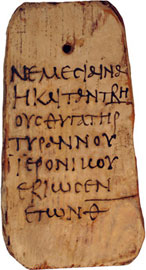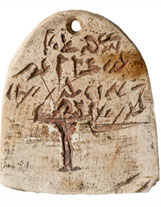Introduction
The Mummy Label Database (MLD) is a joint project of the Oriental Institute of the University of Chicago, the Universitat Pompeu Fabra (Barcelona), and the Universidad Complutense (Madrid). It was established in 2007, when Sofía Torallas Tovar (University of Chicago) and François Gaudard (University of Chicago) decided to join efforts to study mummy labels, a source material that requires linguistic expertise in both Greek and Demotic, among other things. They were soon joined by Raquel Martín Hernández (Universidad Complutense) and Klaas A. Worp (Leiden University), who has extensive experience in the edition of Greek mummy labels. The team grew, adding Alberto Nodar (Universitat Pompeu Fabra), with remarkable skills in papyrology-related databases, and Amalia Zomeño (CCHS-CSIC, Madrid), who specializes in the study of the ancient Arabic civilization, providing a comparative vision into a later period. Additional members also joined the team: María Jesús Albarrán (CCHS-CSIC, Madrid), Irene Pajón (Universidad de Sevilla), Alba de Frutos García (CCHS-CSIC, Madrid), Marina Escolano Poveda (Johns Hopkins University, Baltimore), and Sergio Carro Martín (Universitat Pompeu Fabra), who is the team’s research assistant since 2009.
Over the years the Mummy Label Database has been awarded grants by the Spanish Ministry of Science and Innovation (MICINN), now called Ministry of Economy and Competitivity, and the Fundación la Caixa, supported by the Fundación Bancaria Caixa d’Estalvis i Pensions de Barcelona, “la Caixa,” which the team of the MLD would like to thank for their support and generosity.
There is an approximate number of 2500 known and edited mummy labels, but their being published in various periodicals and journals makes a thorough study all the more difficult to undertake. Therefore, this project is focused on making the already-published labels easily accessible to scholars as an on-line database. In addition, the aim is also to publish as many as possible of the still unpublished labels, to republish all those that have been defectively or incompletely edited, as well as to locate missing ones. Indeed, it is not uncommon for such items to pass from one collection to another and sometimes to disappear and go missing for years until they are eventually rediscovered later. The most difficult labels to track include those which were part of private collections, were sold at private auctions, or disappeared, for example, during World War II.
Mummy labels were used as a means of identifying corpses of the deceased when they had to be transported to the necropolis. Made of wood and more rarely of stone, faience, or even ivory, they were attached to the mummy with a piece of cord and inscribed in Demotic, Greek, sometimes in both languages, or, less commonly, in hieratic or hieroglyphs. These inscriptions usually consist of short texts giving important information, such as the name, parentage, age, place of residence, destination of the deceased, and, in some cases, further indications about, for example, the shipping, lading of the corpses, or else. In addition, especially in the Demotic texts, they often include a short formula for the welfare of the deceased in the hereafter, which testifies to their religious function. These small monuments could even play the role of a cheap substitute for funerary stelae, as sometimes indicated by their shape and the fact that they could be identified as wy.t or στήλη “stela.”
Mummy labels represent a very interesting corpus, which has often been neglected in the study of the material and documentary evidence from ancient Egypt. Looking towards the future, this fully searchable database will certainly be a useful tool for subsequent studies on mummy labels and will contribute to a better understanding of the life of the multicultural population of Graeco-Roman Egypt.
For further information on the project, see the Annual Reports below.



